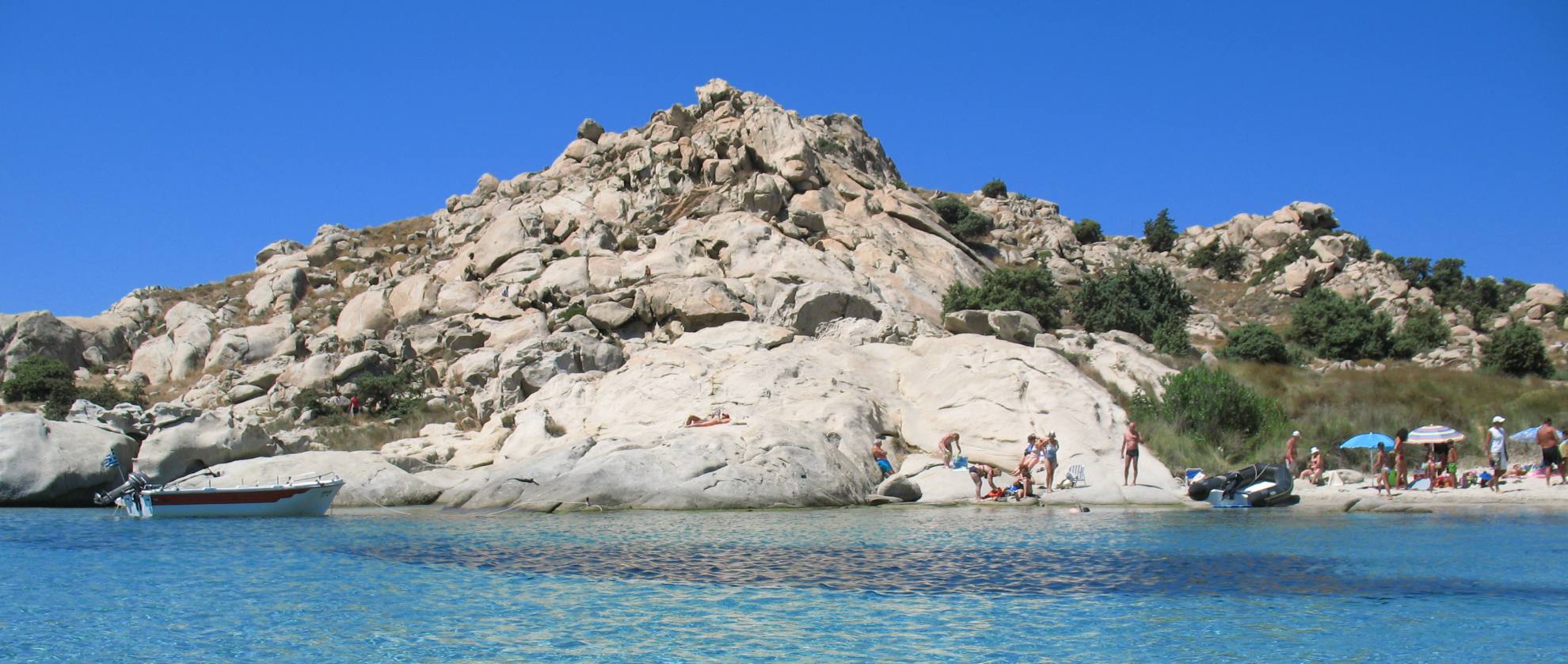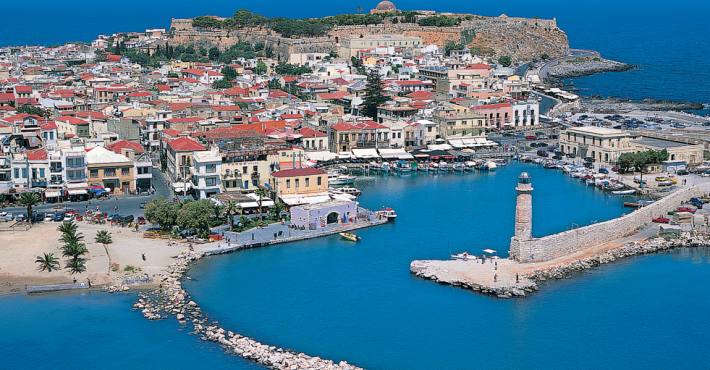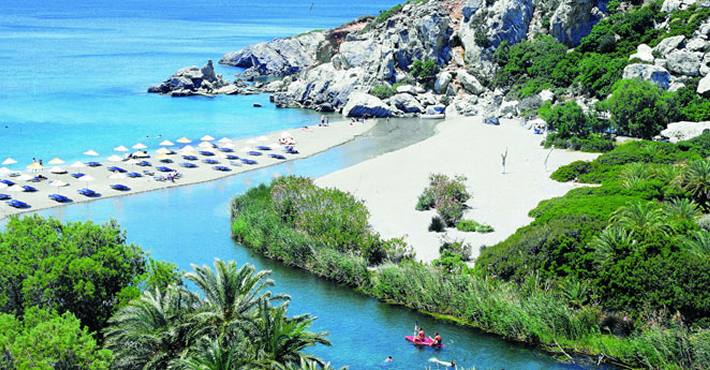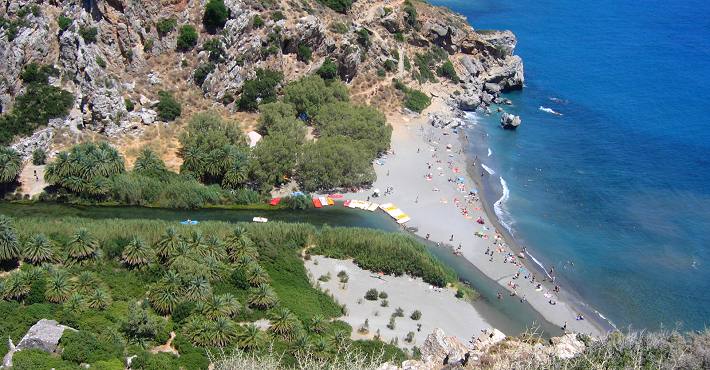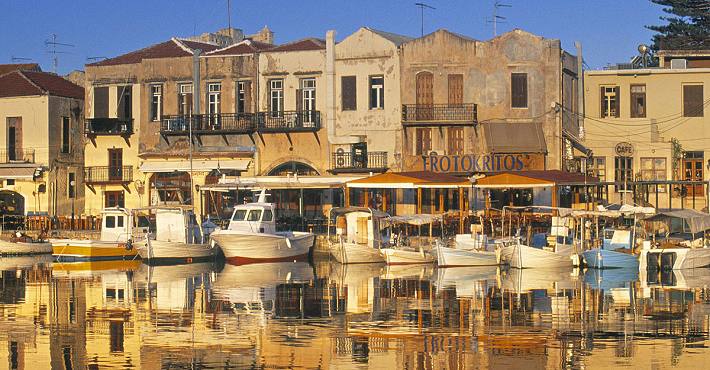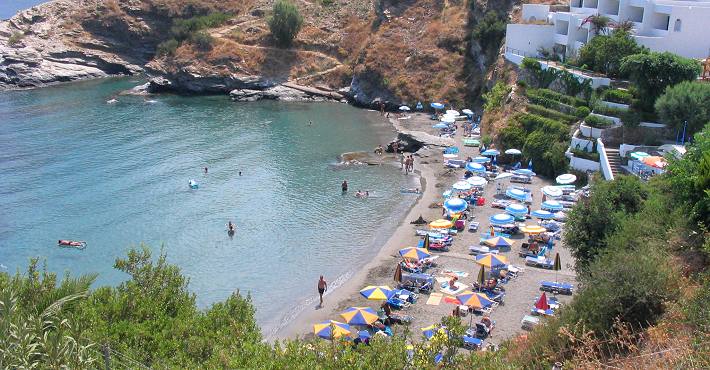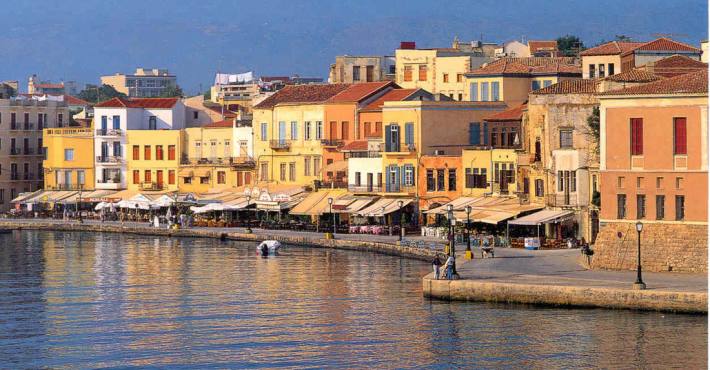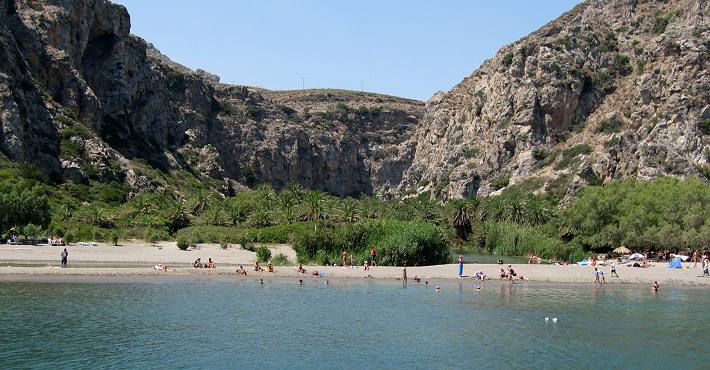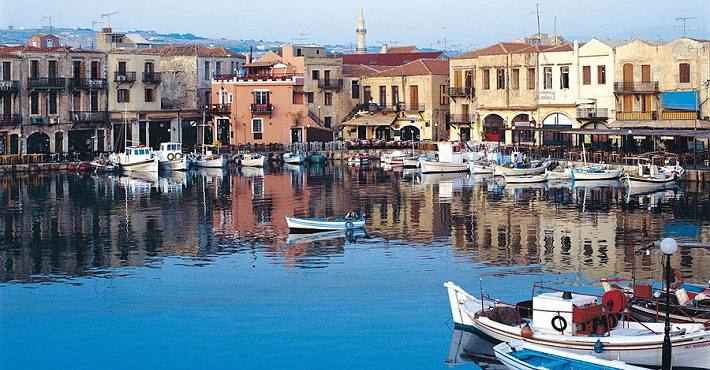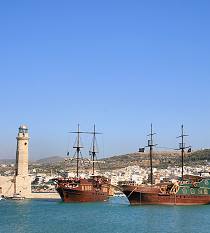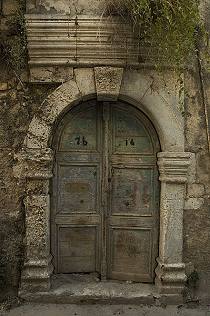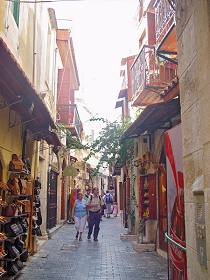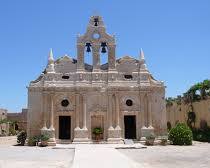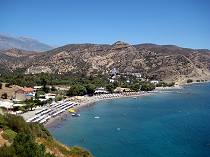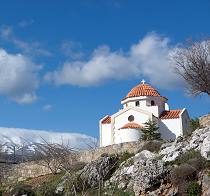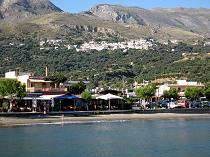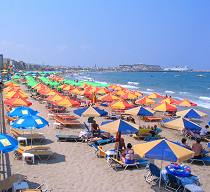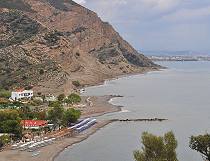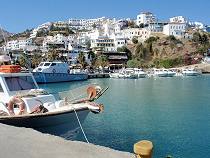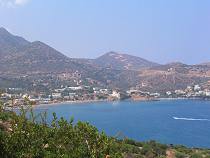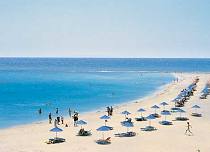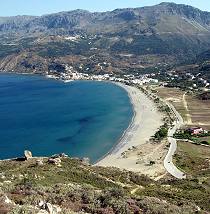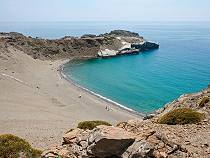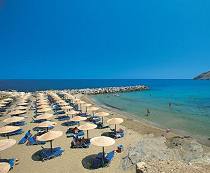Rethymno - The microcosm of all Creete
Rethymno region is the most mountainous of Crete, dominated in the east mount Psiloritis (or Ida). Two of Crete's most famous monasteries, Arkadi and Preveli are in the county. Rethymno county is a microcosm of Crete, it has everything, excellent beaches, popular resorts, undeveloped beaches, fortresses, gorges, rich vegetation, a scenic landscape.
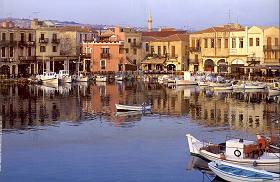 Rethymno town the capital, is a beautiful old town with little winding Venetian and Medieval streets and buildings, an imposing castle and a hors-shaped harbour
filled with tavernas, bars and restaurants.
The old part of the town contains many Venetian palazzos, Turkish houses with wooden balconies and the Venetian citadel with a mosque spanned by a massive dome.
Rethymno town the capital, is a beautiful old town with little winding Venetian and Medieval streets and buildings, an imposing castle and a hors-shaped harbour
filled with tavernas, bars and restaurants.
The old part of the town contains many Venetian palazzos, Turkish houses with wooden balconies and the Venetian citadel with a mosque spanned by a massive dome.
Arkadi Monastery (or Moni Arkadiou) southeast of Rethymno, is the symbol of Cretan resistance to the Ottomans. There during the insurrection of 1866 the abbot Gabriel and 960 (estimated) monks, women, children and villagers blew themselves up by firing powder magazines when confronted by the army of the Ottomans.
Getting There
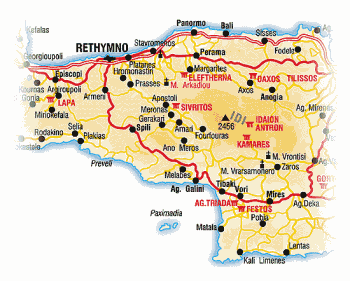 By Sea:
By Sea:
There are ferry connections to Piraeus and Santorini but these routes may vary every year.
Via Chania or Heraklion ports.
By Air:
Via Chania or Heraklion airports.
Rethymno Beaches
North Crete
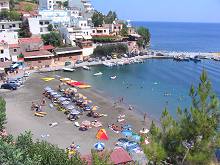 Bali,
Excellent sandy beaches protected from the wind, very picturesque
Bali,
Excellent sandy beaches protected from the wind, very picturesque
Episkopi,
Long beautiful sandy beach
Geropotamos,
Nice beach with sand and pebbles
Panormo,
Beautiful sandy beach
Rethymno,
12 Km of sandy beach
South Crete
Agia Galini ,
Beautiful sandy beach
Agios Pavlos ,
Nice sandy beach
Ammoudi,
Excellent sandy beach
Damnoni,
Beautiful sandy beach
Plakias ,
Beautiful beach with fine sand
Preveli,
Excellent beach with fine sand and palm tree forest
Souda of Plakias,
Very nice sandy beach
Rodakino,
Nice pebbly beach
Places to visit in Rethymno
The Archaeological Museum:
Antiques of the
Rethymno prefecture from Neolithic to Roman years are
on display. The exhibits are organised in chronological order.
Of particular interest is the "filter compass" with the
plant decoration, the "teeth-bordered helmet" and the
coin collection.
Museum of Sea life:
It is housed in the old abbey, which is situated in the old town and has been restored recently. The exhibition represents one of the most important collections in Rethymno including molluscs, sponges, fish and various fossils.
Church Museum:
It was founded in 1994 and is situated in Mitropoleos Square. The museum includes ecclesiastical relics dating back from 1816 up until the present, such as church utensils, icons, bells as well as the clock of the belfry, which had been functioning from 1894 up until 1986.
Arkadi monastery:
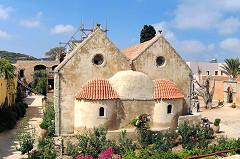 The most significant monastery of Rethymno and maybe the most important in Crete.
It is situated 23 Km from the
town of Rethymno and is built overlooking
three districts. Established in the
14th or 15th century, it constituted
an important revolutionary centre during the Turkish occupation.
The martyrdom of its defenders in 1866
made it well known:
The most significant monastery of Rethymno and maybe the most important in Crete.
It is situated 23 Km from the
town of Rethymno and is built overlooking
three districts. Established in the
14th or 15th century, it constituted
an important revolutionary centre during the Turkish occupation.
The martyrdom of its defenders in 1866
made it well known:
"When the Turkish Pasha in Rethymnon learned of the rebels operating out of the monastery,
he sent an ultimatum to Arkadi's Abbot Gabriel Marinakis:
either expel the revolutionary committee or the monastery would be destroyed.
Abbot Gabriel refused the Pasha's demand.
The rebels began preparing the monastery for the anticipated Turkish attack.
On 7 November 1866 the Turks under Mustafa Kyrtil Pasha with 15,000 Turkish soldiers armed with 30 cannons
attacked Arkadi and after 2 day siege
they breached the walls. Then a fighter named Konstantine Giaboudakis
set fire to gunpowder room, blowing up Greeks and Turks. 864 Cretan men, women and children were dead
along with 1500 Turks.
The Turks took 114 prisoners whom they immediately put to death. Only 3 rebels managed to escape to tell the story".
(source by STIGMES, the magazine of Crete)
The event shocked Europe and won much support Cretan independence.
In 1898, Crete won its independence and the Turks withdrew from the island,
which they had held since 1669.
The gunpowder room where the blast left a gaping hole in the roof can be visited.
Preveli monastery:
The Monastery has a glorious history due to the active and leading involvement of its fellow monks in all national endeavourers for freedom and education.
This monastery is
comprised of two separate building complexes
which are 3 kms apart.
There are strong indications that the first core of the Monastery was organized on the area of the Monastery of Saint John the Baptist or Kato Monastiri (the lower monastery), during the II Byzantine period of Crete, around the 10th or the beginning of the 11th century, when many monasteries were established on the south coast of Crete. The oldest date related to the monastery is 1594, and it is engraved on a bell of the monastery.
A feudal lord known as Prevelis probably founded the monastery during the Venetian occupation.
When in 1649 the Turks occupied Crete, they destroyed numerous church establishments, among them the monastery of Preveli.
Saint John of Gerakari Church:
A cluster of isolated churches, which
was transformed in three
construction stages. It has interesting wall frescoes.
Melidoni cave:
It has been proved that the cave was used as a central place of worship from the early Neolithic age up until the Roman period. An inscription gives evidence of the fact that Hermes was worshipped in this cave. It also played an important role during modern times, more precisely during the Turkish occupation. In January 1834, the Turks besieged the cave, where 370 inhabitants of the village of Melidoni had found shelter, set it on fire and suffocated everybody in it. Their bones are preserved in the memorial sarcophagus situated in the first hall. The cave is open to visitors.
Touring Rethymno
Rethymno
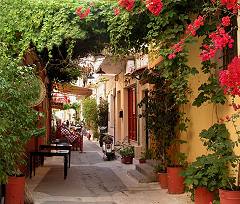 Rethymnon with much of its holiday accommodation spread behind the mile long sandy beach, also attracts the visitor with a sense of history.
Dominated by a Venetian fortress, the old town has bags of atmosphere.
Its quaint little fishing harbour is particularly attractive in the evenings when water's edge tavemas are lit up.
A Venetian fortress, a beautiful old town, a palm-lined promenade, a long sandy beach complete with water sports, lively bars and tempting tavernas, old and new blend happily in Rethymno.
Rethymnon with much of its holiday accommodation spread behind the mile long sandy beach, also attracts the visitor with a sense of history.
Dominated by a Venetian fortress, the old town has bags of atmosphere.
Its quaint little fishing harbour is particularly attractive in the evenings when water's edge tavemas are lit up.
A Venetian fortress, a beautiful old town, a palm-lined promenade, a long sandy beach complete with water sports, lively bars and tempting tavernas, old and new blend happily in Rethymno.
When the Venetians came to Rethymno they established themselves in the Castel Vecchio, the first building centre of the town. The Castel Vecchio included a very small area and was surrounded by a fortified wall. Later, the expansion of the settlement beyond that wall demanded the construction of a new wall, which would include a larger area. This was carried out during the period between 1540 and 1570. The new fortification of the building complex included a magnificent entrance gate, the Porta Guora, which led to the central square, where the superb public buildings such as the Loggia, the Rimondi Fountain and the sundial tower were situated.
In 1571 the wall was devastated during the raids. Thus it became absolutely vital to fortify the hill of Palaiokastro (Old Castle) and to relocate the entire city there. Many problems had to be solved before the Fortezza was finally built during the period between 1573 and 1578. However, the city was never transferred to the safe area within the walls.
The Great Gate of the city of Rethymno, the Porta Guora, is one of the few remains of the city's initial fortification. The name is derived from the Rettore J. Guoro, who was in office during the period of its construction (1566-1568). It is situated at the entrance of Antistaseos Street and up to the present it has been preserved, 2.60 m wide and with a semi-circular arch. Originally it included a crown in its gable with the relief of the lion of St. Marko in the tympanum.
The Loggia of Rethymno, situated in the centre of the city, was a magnificent building, where the nobility met to discuss political and economic issues. It dates back to the 16th century and was built according to the plans of the famous Venetian architect Michele Sanmicheli. The well-preserved building has a square ground plan with three vaulted sides (the west side is not vaulted). It is built of regular sized stones and the projections of the cornice are particularly beautiful. Originally the building was open and had a four-sided roof, qualities which do not apply any more today.
The Mosque Neratzes: During Venetian occupation the mosque Neratzes, which today is used as a music school, was the Augustinian church of the Holy Virgin. In 1657 the Turks transformed it into the mosque Gazi Housein or Neratze, and in 1890 they added a large minaret with two galleries, which was built from the famous stones from the village of Alfa. The chapel of the Holy Virgin, situated at its west side and dedicated to the Body of Christ, was also transformed into a seminary. Outstanding elements of this building are the doorframe and the three domes.
The Rimondi Fountain: A. Rimondi, the Rector of the city, built the famous Rimondi Fountain, which is situated at present day Platanos Square, formerly the centre of Venetian city life, in 1626. The water runs from three spouts in the shape of a lion's head into three sinks. Three small, fluted columns, ornamented with Corinthian capitals are "standing" on the sinks. Above the capitals an entablature can be observed, the middle part of which displays four projections in the shape of the leaves of the acanthus exactly above the columns. Furthermore in this section the words LIBERALITATIS and FONTES are inscribed.
Agia Galini
Built on a hillside, sweeping down to a little fishing harbour and sandy beach.
The abundance of tavemas, shops and bars and the wide variety of entertainment make this one of the most popular resorts in Crete.
Amnatos
Amnatos has very few inhabitants and lies on the road to the historic Monastery of Arkadi,
in a beautiful hilly location.
Interesting architectural elements have been preserved in the village,
in particular the doorway of the restored Venetian mansion of the Sanguinazzo in the village square.
On the spandrel there is the inscription: INITIUM SAPIENTIE TIMOR DOMNI
(the beginning of wisdom is the fear of the Lord).
In the settlement of Amnatos there is a folk museum.
Anogia
Anogia is a small town, built at an altitude of
750 m on Mt. Psiloritis. It was often burned down in the
past by its conquerors, before being levelled in 1944. It
offers rooms to rent, restaurants, a folklore museum and
shops selling woven products. Here, the visitor can visit
the Idaean cave (26 Km) in which, according to mythology, Zeus
was born. (According to another legend, Zeus was born in Dikteon Andro cave in Lassithi county).
Apostoli
The view is overwhelming from this beautiful settlement, located amphitheatre-like on the slopes of a hill and swathed in greenery. The history of the settlement goes back many centuries, to 260 AD and the Roman persecution of the Ten Saints which gave it its name. Today, the village constitutes a lively presence amidst a superb natural landscape.
The Town Hall of the Municipality of Syvritos is located here, and the settlement of Agia Fotini has developed into a dynamic centre for the region. The main church of the village, that of Agios Nikolaos, has been preserved; it is a single-aisled basilica with wall-paintings dating from the 14th century. The churches of Agios Spyridon within the village, and Agios Onoufrios in Genna, are both Byzantine.
Argyroupoli
Built on the ruins of ancient Lappa,
Argyroupoli keeps its traditional character. The visitor can
enjoy the greenery of the village, can stay in tourist
farmhouses and dine in the cool leafy area of "Agia Dynami", directly north of the village.
Bali
Once a small fishing village which it has today developed with tourism.
Nestling in the surrounding mountains of the bay of Bali you will find the coastal village of the same name 34 km east of Rethymno. Visitors may choose from which of the small inlets to enjoy bathing at organised beaches.
The area offers a large number of tavernas, hotels and rooms.
The monastery of Saint John is worth a visit.
Myrthios
The village of Myrthios is situated on the southern slope of the Kouroupa hill,
in an amphitheatre-like location which offers a unique view out over the
Gulf of Plakias and the Libyan Sea.
Its existence was mentioned for the first time in 1583, with a population of 87;
today there are over 200 inhabitants.
Within the village there is the little frescoed Church of the
Metamorphosis of Christ the Saviour.
Predominant among the wall-paintings is that of the Virgin (Theotokos Platytera)
with Christ, in the niche of the Sanctum;
the four Hierarchs are depicted immediately below it.
In the surroundings of the settlement
there is a large water mill which dates from the 19th century;
both the mill itself and the water tower with the mill-dwelling are preserved.
Langa
This village is situated on the top of a hill and has less than 100 inhabitants.
A number of houses dating from the Venetian occupation and subsequent
period are preserved within it, thus its architectural
physiognomy has been retained to this day.
The restored Church of the Virgin Hypapantis was formerly the chapel of the Monastery of the Blessed Virgin Mary. The Folklore Collection of Langa has been housed in the Primary School since 1993. Near to the village, in an area of extreme natural beauty, there is the "Elliniki Kamara", a bridge dating from the Hellenistic period and preserved in good condition.
Plakias
The village of Plakias is situated 40 km south of Rethymno. This resort boasts a superb sandy beach, and the well-organised infrastructure includes hotels, rooms, tavernas and restaurants. The organised beach offers both bathing and various water sports.
Preveli
38km south of Rethymno, shortly before you arrive at the historic Monastery of Preveli, a track on the left hand side leads downhill to a parking place. After approximately 15-minutes downhill walk you arrive at the beautiful sandy beach with palm trees, where the River Kourtaliotis empties into the sea.
Roustika
Roustika is a beautiful village with 310 inhabitants, in an amphitheatre-like location smothered in greenery. It was first mentioned in 1577 and has retained its special architectural physiognomy to this day. At the centre of the village there is the Church of the Assumption of the Virgin Mary, dating from 1380, with frescoes in its northern aisle. To the southeast of the village there is the Monastery of Profitis Elias, the building of which – according to inscriptional evidence – began in 1637. The monastery played a significant role throughout the period of the Turkish occupation, functioning as a school and participating in the revolutionary struggles. It now houses a museum. There is also a private museum of Greek traditional costumes in Roustika.
